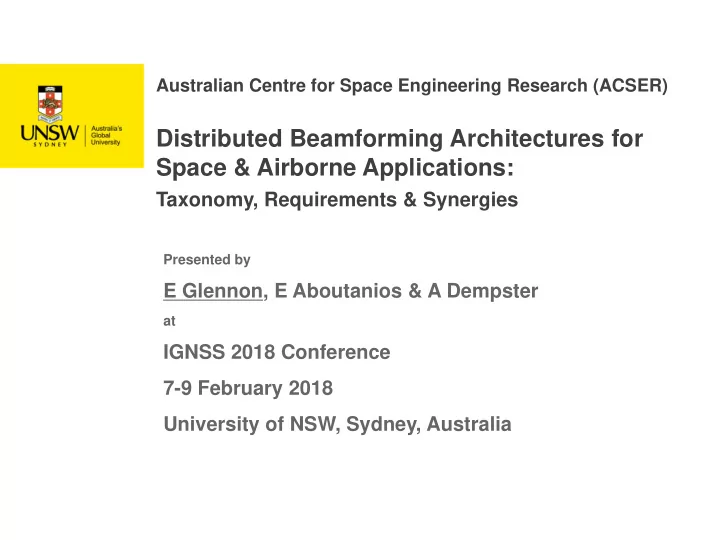

IGNSS2018: 7 - 9 February 2018 Australian Centre for Space Engineering Research (ACSER) Distributed Beamforming Architectures for Space & Airborne Applications: Taxonomy, Requirements & Synergies Presented by E Glennon, E Aboutanios & A Dempster at IGNSS 2018 Conference 7-9 February 2018 University of NSW, Sydney, Australia Slide 1
IGNSS2018: 7 - 9 February 2018 Airborne & Spaceborne Distributed Beamforming • Many terms for the same concept: - collaborative beamforming, cooperative reception, virtual antenna arrays, distributed antenna arrays, synthesized antenna arrays, … • Basic idea : - Use physically separated antennas to achieve improved sensitivity / resolution / interference rejection / et cetera compared with a single antenna BUT - the antennas are on unconnected mobile platforms • Example : - Very Long Baseline Interferometry (VLBI) radio astronomy using airborne or spaceborne platforms with multiple receivers Slide 2
IGNSS2018: 7 - 9 February 2018 Spaceborne Distributed Beamformer • Multiple receive/transmit antennas (SV0, SV1, SV2, SV3, …) • Each with different trajectories and independent clocks • Receive signals need to be combined or transmit signals steered • Questions - What architectures are there? - What are the system level requirements? What are the sub-systems needed? - What are the difficulties? Why? Slide 3
IGNSS2018: 7 - 9 February 2018 Architectures and Taxonomy • Fixed or Mobile – only interested in Mobile here • Receiver / Transmitter / Receiver-Transmitter (Transceiver) • Streaming or Post-processing Slide 4
IGNSS2018: 7 - 9 February 2018 MB Receiver Requirements 1 & 2 • Receive RF from target with multiple physically separated antenna - Receive antenna & radio • Transmit downconverted RF (IF) to a reference receiver for processing - Transmit antenna & radio • Streaming MBR illustrated – SV0 is the reference node performing the beamforming Slide 5
IGNSS2018: 7 - 9 February 2018 MB Receiver Requirements 3 & 4 • Be capable of determining the system geometry to within (say) 1/10 of a wavelength of the RF carrier - Relative navigation capability required • Be capable of determining reference frequency clock bias/drift of the locally generated RF carrier to within (say) 1/10 of a wavelength - Synchronisation / syntonisation capability required • The attitude of each node should be measurable to allow for lever-arm effects between the radio-navigation antennas and the beam-forming antennas Slide 6
IGNSS2018: 7 - 9 February 2018 MB Receiver Requirements 5 & 6 • Reference receiver shall to use signals, geometry, timing information to perform required beamforming • Geometry of the receiver network shall be controllable to achieve desired outcome • MB Transmitter Requirements are similar, but differ in that each node is required to adjust the phase & frequency of its transmission so that beamforming can take place. • MB Transmitters also suffer from the ‘thinned array curse’, which limits their use for delivering power Slide 7
IGNSS2018: 7 - 9 February 2018 MB Receiver Requirement List • Receive RF from target with multiple physically separated antenna - Receive antenna & radio • Transmit downconverted IF to a reference receiver for processing - Transmit antenna & radio • Be capable of determining the system geometry to within (say) 1/20 of a wavelength of the RF carrier - Relative navigation capability required, more difficult for higher frequency RF • Be capable of determining reference frequency clock bias/drift of the locally generated RF carrier to within (say) 1/20 of a wavelength - Synchronisation / syntonisation capability required • Reference receiver shall to use signals, geometry, timing information to perform required beamforming • Geometry of the receiver network shall be controllable to achieve desired outcome Slide 8
IGNSS2018: 7 - 9 February 2018 Tx / Nav / Synchronisation Synergies • Mobile distributed beamformers required to operate in real time require high capacity communications between nodes - Needed to perform the weighted summations for beamforming • Mobile distributed beamforming is difficult because the navigation and timing constraints are so demanding BUT • The presence of the communications also provides the opportunity to perform some degree of synchronisation & syntonisation - Provided a COMS system capable of synchronisation/syntonisation is used, which is not true for most COTS chipsets • Whether such an addition would allow GPS to be replaced depends on its performance • Challenging to meeting these requirements even with real-time- kinematic (RTK) carrier phase GPS because RTK doesn’t provide synchronisation Slide 9
IGNSS2018: 7 - 9 February 2018 TerraSAR-X / TanDEM-X Example • TerraSAR-X & Tandem-X are 1250 kg formation flying SAR satellites that fly within 300 m of each other • Satellites use dual frequency RTK CPH GPS for navigation and a custom synchronisation system 3.84 m 2 phased array antenna at 9.8 GHz with 300 MHz bandwidth • Now consider substituting TanDEM-X with a BeamForming Cubsat constellation and assume that L or S band is being used instead of X band • Multiple 6U cubesats (<12kg/SV) or 12 U cubesats (<24kg/SV) 2U Deployable antennas with a surface area of 1.7 m 2 at 3 GHz & • gain of 30 dBi are available Slide 10
IGNSS2018: 7 - 9 February 2018 Conclusions • Plenty of scope for good research • Very challenging due to the required: - Navigation precision - Timing (phase) synchronisation & (frequency) syntonisation precision - High capacity wireless communication between nodes - On-board processing to perform the required beamforming Slide 11
Recommend
More recommend